The global membrane separation technology market is likely to reach from USD 34.6 billion in 2025 to approximately USD 114.4 billion by 2035, recording an absolute increase of USD 79.7 billion over the forecast period. This translates into a total growth of 230.5%, with the market forecast to expand at a compound annual growth rate (CAGR) of 12.7% between 2025 and 2035. The market size is expected to grow by nearly 3.31X during the same period, supported by the rising adoption of advanced water treatment technologies and increasing demand for specialized separation processes in industrial applications.
Between 2025 and 2030, the market is projected to expand from USD 34.6 billion to USD 66.8 billion, resulting in a value increase of USD 32.2 billion, which represents 40.5% of the total forecast growth for the decade. This phase of growth will be shaped by rising adoption of water treatment technologies, increasing industrial processing activities requiring specialized separation systems, and growing environmental regulations driving demand for advanced filtration solutions. Companies are expanding their membrane technology portfolios to address the growing complexity of modern water treatment and industrial separation requirements.
From 2030 to 2035, the market is forecast to grow from USD 66.8 billion to USD 114.4 billion, adding another USD 47.4 billion, which constitutes 59.5% of the overall ten-year expansion. This period is expected to be characterized by expansion of desalination projects, integration of advanced membrane materials, and development of energy-efficient separation technologies across different industrial applications. The growing adoption of circular economy principles and water reuse initiatives will drive demand for more sophisticated membrane systems and specialized technical expertise.
Between 2020 and 2025, the Membrane Separation Technology market experienced steady expansion, driven by increasing water scarcity concerns and growing demand for clean water solutions globally. The market developed as industrial facilities recognized the need for efficient separation technologies to meet environmental regulations and operational efficiency requirements. Water utilities and industrial companies began emphasizing advanced membrane systems to maintain water quality standards and reduce environmental impact.
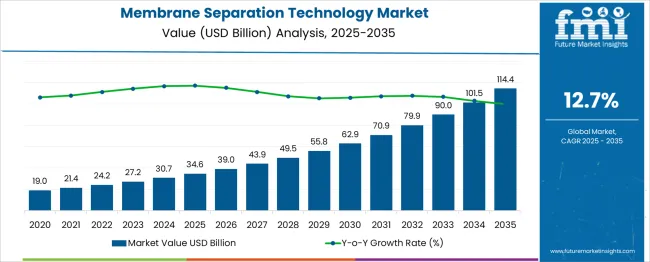
| Metric | Value |
| Estimated Value in (2025E) | USD 34.6 billion |
| Forecast Value in (2035F) | USD 114.4 billion |
| Forecast CAGR (2025 to 2035) | 12.7% |
Market expansion is being supported by the rapid increase in water treatment infrastructure development worldwide and the corresponding need for efficient separation technologies to address growing water quality challenges. Modern industrial operations rely on precise membrane separation systems to ensure proper treatment of water and wastewater while maintaining operational efficiency and environmental compliance. Even minor improvements in separation efficiency can result in significant cost savings and environmental benefits for industrial facilities and water utilities.
The growing complexity of industrial wastewater streams and increasing regulatory requirements are driving demand for advanced membrane separation technologies from certified providers with appropriate technical expertise and quality systems. Environmental regulations are increasingly requiring comprehensive treatment of industrial discharge and water reuse to maintain compliance and reduce environmental impact. Treatment specifications and quality standards are establishing standardized separation protocols that require specialized membrane technologies and validated performance capabilities.
The market is segmented by technology outlook, application outlook, and region. By technology outlook, the market is divided into reverse osmosis, microfiltration, ultrafiltration, nanofiltration, and others. Based on application outlook, the market is categorized into water and wastewater treatment, industry processing, food and beverage processing, pharmaceutical and medical, and others. Regionally, the market is divided into North America, Europe, East Asia, South Asia & Pacific, Latin America, and Middle East & Africa.
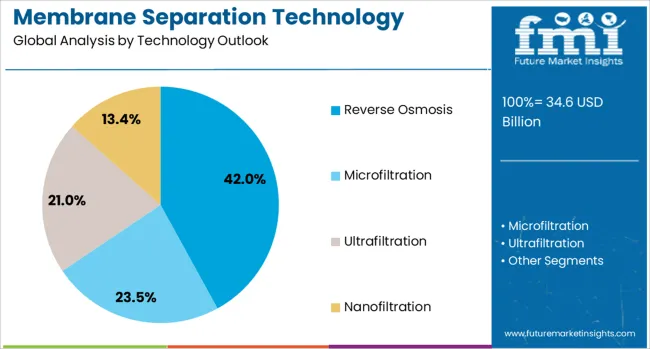
Reverse osmosis is projected to account for 42.0% of the membrane separation technology market in 2025. This leading share is supported by the widespread adoption of reverse osmosis systems for desalination applications and water purification processes that require comprehensive contaminant removal. Reverse osmosis provides superior separation capabilities for dissolved solids and contaminants, making it the preferred technology for most municipal water treatment and industrial water purification applications. The segment benefits from established manufacturing processes and comprehensive performance validation for critical water treatment applications.
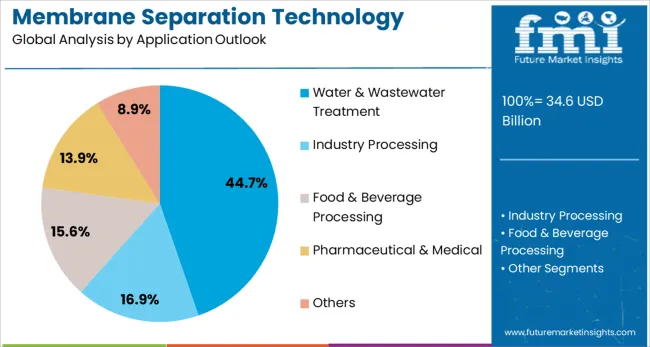
Water and wastewater treatment is expected to represent 44.7% of membrane separation technology demand in 2025. This dominant share reflects the extensive use of membrane technologies in municipal water treatment systems and the growing investment in wastewater treatment infrastructure globally. Modern water treatment facilities require specialized membrane systems to meet stringent water quality standards and regulatory requirements for safe water supply and environmental protection. The segment benefits from increasing government investment in water infrastructure and growing awareness of water quality importance.
The Membrane Separation Technology market is advancing steadily due to increasing water treatment infrastructure development and growing recognition of membrane technology advantages for separation applications. The market faces challenges including high membrane replacement costs, need for continuous maintenance and monitoring, and varying performance requirements across different industrial applications. Technology advancement programs and efficiency improvement initiatives continue to influence product development and market adoption patterns.
The growing development of energy-efficient membrane systems is enabling reduced operational costs while maintaining superior separation performance for water treatment and industrial applications. Advanced membrane materials and optimized system designs provide improved permeate flux and reduced energy consumption compared to traditional separation technologies. These systems are particularly valuable for large-scale desalination projects and industrial facilities that require cost-effective separation solutions with minimal environmental impact.
Modern membrane separation systems are incorporating advanced monitoring technologies and automated control systems that improve operational efficiency and reduce maintenance requirements. Integration of real-time performance monitoring and predictive maintenance capabilities enables optimized membrane performance and extended system lifespan. Advanced control systems also support automated cleaning protocols and membrane replacement scheduling that maintain consistent separation performance.
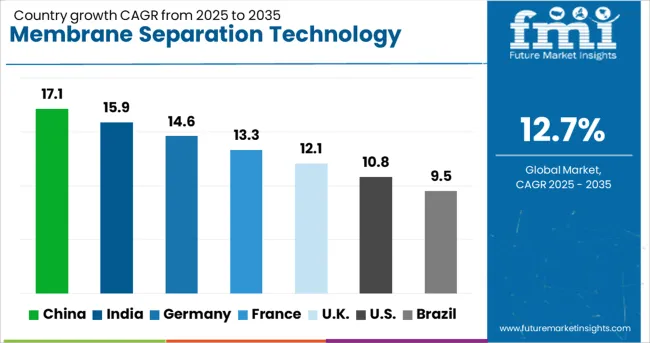
| Country | CAGR (2025-2035) |
| China | 17.1% |
| India | 15.9% |
| Germany | 14.6% |
| France | 13.3% |
| UK | 12.1% |
| USA | 10.8% |
| Brazil | 9.5% |
The membrane separation technology market demonstrates strong growth patterns across key regions, with China leading at 17.1% CAGR through 2035, driven by expanding water treatment infrastructure and increasing industrial processing requirements. India follows at 15.9%, supported by growing water scarcity concerns and infrastructure development programs. Germany records 14.6% growth, emphasizing advanced membrane technologies and industrial processing capabilities, while France shows 13.3% expansion through water treatment facility modernization programs. The UK demonstrates 12.1% growth through environmental regulation compliance initiatives, the USA shows 10.8% driven by infrastructure replacement activities, and Brazil records 9.5% supported by water treatment infrastructure development efforts.
The membrane separation technology market in China is projected to exhibit the highest growth rate with a CAGR of 17.1% through 2035, driven by rapid expansion of water treatment infrastructure and increasing investments in industrial wastewater treatment capabilities. The country's growing manufacturing industry and urban development programs are creating significant demand for advanced membrane systems and specialized water treatment solutions. Major industrial facilities and municipal utilities are establishing comprehensive membrane separation capabilities to support both environmental compliance and operational efficiency requirements.
Government water treatment development programs support establishment of modern treatment facilities that meet environmental standards and water quality requirements for green development. Industrial wastewater treatment initiatives facilitate adoption of advanced membrane technologies that support comprehensive separation capabilities across major manufacturing regions.
The membrane separation technology in India is expanding at a CAGR of 15.9%, supported by increasing water treatment infrastructure development and growing industrial processing requirements. The country's expanding manufacturing sector and increasing water scarcity concerns are driving demand for efficient membrane separation systems and water treatment solutions. Municipal utilities and industrial facilities are gradually establishing comprehensive membrane technology capabilities to serve growing water treatment requirements.
Water infrastructure development programs and industrial expansion create opportunities for specialized membrane technology providers that can support diverse treatment applications and regulatory compliance requirements. Professional training and technical development programs enhance operational expertise among water treatment facilities, enabling comprehensive membrane system utilization that meets quality standards.
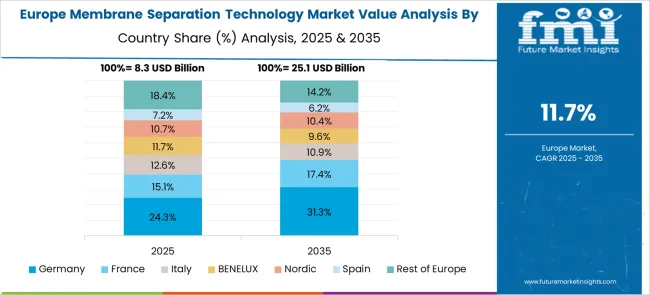
Demand for membrane separation technology in Germany is projected to grow at a CAGR of 14.6%, supported by the country's emphasis on industrial processing innovation and advanced water treatment capabilities. German manufacturing companies are implementing comprehensive membrane systems that meet stringent environmental standards and operational efficiency requirements for industrial applications. The market is characterized by focus on technological advancement, quality assurance programs, and compliance with comprehensive environmental protection regulations.
Industrial processing investments prioritize advanced membrane technologies that demonstrate superior separation performance while meeting German environmental quality standards. Professional certification programs ensure comprehensive technical expertise among facility operators, enabling specialized membrane applications that support diverse industrial processing requirements.
The membrane separation technology market in France is growing at a CAGR of 13.3%, driven by ongoing water treatment facility upgrades and increasing industrial processing investments in separation capabilities. The country's established water treatment infrastructure and growing focus on water reuse applications are creating demand for advanced membrane systems and optimized treatment solutions. Municipal utilities and industrial facilities are investing in modern membrane technology to support comprehensive water treatment programs.
Water treatment infrastructure modernization facilitates adoption of advanced membrane technologies that support comprehensive separation capabilities across major treatment and industrial centers. Technical development programs enhance membrane technology expertise among facility operators, enabling specialized system utilization procedures that meet evolving environmental requirements.
Demand for membrane separation technology in the UK is expanding at a CAGR of 12.1%, driven by continued environmental regulation compliance and water treatment innovation activities. The country's established water treatment infrastructure and growing investment in industrial wastewater treatment are creating demand for specialized membrane systems and advanced separation capabilities. Water utilities and industrial companies are establishing comprehensive membrane technology capabilities to maintain regulatory compliance in environmental protection requirements.
Environmental compliance investments prioritize advanced membrane applications that support regulatory requirements while maintaining operational efficiency and cost effectiveness. Industry and regulatory collaboration programs facilitate technology advancement and expertise development that enhance membrane system capabilities across treatment networks.
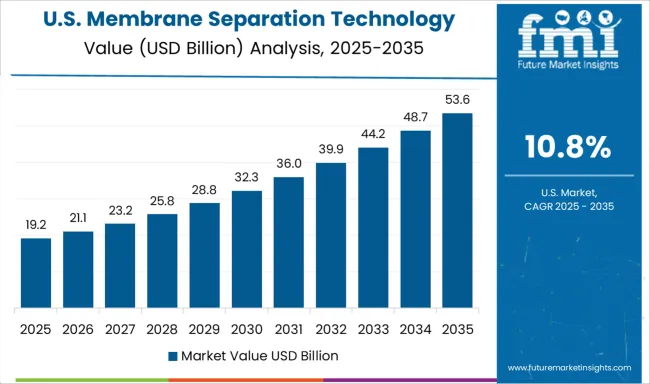
Demand for membrane separation technology in the USA is expanding at a CAGR of 10.8%, driven by increasing water treatment infrastructure replacement and growing emphasis on standardized separation processes for municipal and industrial applications. Large water utilities and industrial facilities are establishing comprehensive membrane system programs to serve diverse treatment requirements. The market benefits from regulatory agency requirements for water quality compliance and environmental protection following infrastructure modernization activities.
Water treatment industry consolidation enables standardized membrane technology utilization across multiple treatment facilities, providing consistent water quality and comprehensive regulatory compliance throughout distribution networks. Professional training and certification programs develop specialized technical expertise among facility operators, enabling comprehensive membrane capabilities that support evolving treatment requirements.
Demand for membrane separation technology in Brazil is growing at a CAGR of 9.5%, driven by increasing water treatment infrastructure modernization and growing industrial processing investment in separation capabilities. The country's expanding manufacturing sector and increasing focus on environmental compliance are creating opportunities for membrane technology providers and treatment system suppliers. Municipal utilities and industrial companies are gradually integrating advanced membrane systems to support water treatment and wastewater processing programs.
Water treatment infrastructure modernization facilitates adoption of advanced membrane technologies that support comprehensive treatment capabilities across major municipal and industrial regions. Professional service development programs enhance technical capabilities among treatment facilities, enabling specialized membrane applications that meet evolving environmental and operational requirements.
The membrane separation technology market in Europe is projected to grow steadily over the forecast period, with established water treatment infrastructure and industrial processing centers driving consistent demand for advanced separation systems. Germany is expected to maintain market leadership supported by its extensive industrial manufacturing base and water treatment technology investments. The European market demonstrates strong emphasis on advanced environmental compliance standards and comprehensive water treatment technologies, particularly in municipal water treatment applications and industrial wastewater processing requirements. Germany's leadership position reflects its robust manufacturing sector and stringent environmental regulations for water treatment applications, while France's substantial market presence indicates significant investment in water infrastructure modernization and industrial processing capabilities.
European membrane separation technology demand patterns show concentration in high-performance treatment applications, with reverse osmosis and ultrafiltration systems representing dominant technology segments across major markets. The region's strict environmental regulatory frameworks and water quality standards drive preference for certified membrane technology providers, supporting premium system adoption and specialized technical relationships. Germany's industrial processing and water treatment clusters, France's infrastructure modernization programs, and the United Kingdom's environmental compliance activities collectively establish Europe as a critical market for advanced membrane separation technologies. Regional technology development networks and operational expertise advancement continue to strengthen European market position in global water treatment and industrial separation applications.
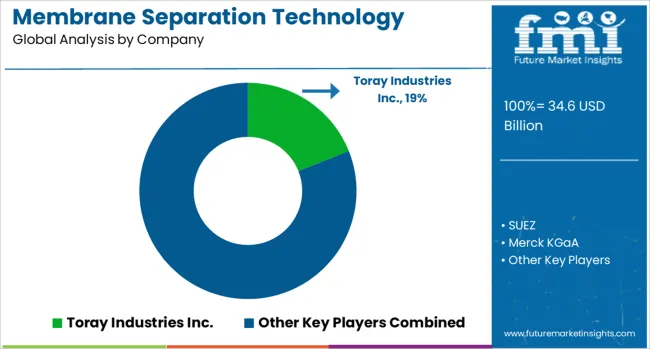
The membrane separation technology market is defined by competition among specialized water treatment companies, industrial equipment manufacturers, and membrane technology providers. Companies are investing in advanced membrane materials, energy-efficient separation systems, automated monitoring technologies, and comprehensive technical support to deliver reliable, cost-effective, and environmentally compliant separation solutions. Strategic partnerships, technological innovation, and geographic expansion are central to strengthening product portfolios and market presence in the rapidly evolving water treatment and industrial processing landscape.
Major players in the market include Toray Industries Inc., recognized for comprehensive membrane technology solutions and global manufacturing capabilities. SUEZ offers specialized water treatment systems with focus on municipal and industrial applications. Merck KGaA provides diverse membrane separation technologies for pharmaceutical and industrial processing applications. Pentair emphasizes advanced filtration systems and water treatment solutions, while Nitto focuses on reverse osmosis and nanofiltration membrane technologies. Additional market participants include AXEON Water Technologies, GEA Group, Hyflux, Koch Membrane Systems, Corning Incorporated, HUBER SE, Pall Corporation, 3M Company, Asahi Kasei Corporation, and DuPont de Nemours Inc., each contributing specialized expertise in membrane separation technologies and supporting infrastructure for water treatment and industrial processing applications.
| Item | Value |
| Quantitative Units | USD 114.4 billion |
| Technology Outlook | Reverse Osmosis, Microfiltration, Ultrafiltration, Nanofiltration, and Others |
| Application Outlook | Water & Wastewater Treatment, Industry Processing, Food & Beverage Processing, Pharmaceutical & Medical, and Others |
| Regions Covered | North America, Europe, East Asia, South Asia & Pacific, Latin America, Middle East & Africa |
| Country Covered | United States, Germany, India, China, United Kingdom, Japan, Brazil |
| Key Companies Profiled | Toray Industries Inc., SUEZ, Merck KGaA, Pentair, Nitto, AXEON Water Technologies, GEA Group, Hyflux, Koch Membrane Systems, Corning Incorporated, HUBER SE, Pall Corporation, 3M Company, Asahi Kasei Corporation, and DuPont de Nemours, Inc. |
| Additional Attributes | Dollar sales by technology outlook and application outlook, regional demand trends across North America, Europe, and Asia-Pacific, competitive landscape with established players and emerging technology companies, buyer preferences for energy-efficient versus conventional membrane systems, integration with advanced monitoring and automation platforms, innovations in membrane materials and separation efficiency technologies, and adoption of green treatment solutions with comprehensive environmental compliance and operational optimization features. |
The global membrane separation technology market is estimated to be valued at USD 34.6 billion in 2025.
The market size for the membrane separation technology market is projected to reach USD 114.4 billion by 2035.
The membrane separation technology market is expected to grow at a 12.7% CAGR between 2025 and 2035.
The key product types in membrane separation technology market are reverse osmosis, microfiltration, ultrafiltration and nanofiltration.
In terms of application outlook, water & wastewater treatment segment to command 44.7% share in the membrane separation technology market in 2025.






Our Research Products

The "Full Research Suite" delivers actionable market intel, deep dives on markets or technologies, so clients act faster, cut risk, and unlock growth.

The Leaderboard benchmarks and ranks top vendors, classifying them as Established Leaders, Leading Challengers, or Disruptors & Challengers.

Locates where complements amplify value and substitutes erode it, forecasting net impact by horizon

We deliver granular, decision-grade intel: market sizing, 5-year forecasts, pricing, adoption, usage, revenue, and operational KPIs—plus competitor tracking, regulation, and value chains—across 60 countries broadly.

Spot the shifts before they hit your P&L. We track inflection points, adoption curves, pricing moves, and ecosystem plays to show where demand is heading, why it is changing, and what to do next across high-growth markets and disruptive tech

Real-time reads of user behavior. We track shifting priorities, perceptions of today’s and next-gen services, and provider experience, then pace how fast tech moves from trial to adoption, blending buyer, consumer, and channel inputs with social signals (#WhySwitch, #UX).

Partner with our analyst team to build a custom report designed around your business priorities. From analysing market trends to assessing competitors or crafting bespoke datasets, we tailor insights to your needs.
Supplier Intelligence
Discovery & Profiling
Capacity & Footprint
Performance & Risk
Compliance & Governance
Commercial Readiness
Who Supplies Whom
Scorecards & Shortlists
Playbooks & Docs
Category Intelligence
Definition & Scope
Demand & Use Cases
Cost Drivers
Market Structure
Supply Chain Map
Trade & Policy
Operating Norms
Deliverables
Buyer Intelligence
Account Basics
Spend & Scope
Procurement Model
Vendor Requirements
Terms & Policies
Entry Strategy
Pain Points & Triggers
Outputs
Pricing Analysis
Benchmarks
Trends
Should-Cost
Indexation
Landed Cost
Commercial Terms
Deliverables
Brand Analysis
Positioning & Value Prop
Share & Presence
Customer Evidence
Go-to-Market
Digital & Reputation
Compliance & Trust
KPIs & Gaps
Outputs
Full Research Suite comprises of:
Market outlook & trends analysis
Interviews & case studies
Strategic recommendations
Vendor profiles & capabilities analysis
5-year forecasts
8 regions and 60+ country-level data splits
Market segment data splits
12 months of continuous data updates
DELIVERED AS:
PDF EXCEL ONLINE
Membrane Filter Press Solutions Market Size and Share Forecast Outlook 2025 to 2035
Membrane Filter Press Machines Market Size and Share Forecast Outlook 2025 to 2035
Membrane Switch Market Size and Share Forecast Outlook 2025 to 2035
Membrane Filtration Systems Market Size and Share Forecast Outlook 2025 to 2035
Membrane Microfiltration Market Size and Share Forecast Outlook 2025 to 2035
Membrane Filter Cartridge Market Size and Share Forecast Outlook 2025 to 2035
Membrane Boxes Market Size and Share Forecast Outlook 2025 to 2035
Membrane Chemicals Market Growth - Trends & Forecast 2025 to 2035
Membrane Air Dryers Market Growth - Trends & Forecast 2025 to 2035
Market Leaders & Share in Membrane Boxes Manufacturing
Membrane Separation Ammonia Cracker Market Size and Share Forecast Outlook 2025 to 2035
Geomembrane Market Strategic Growth 2024-2034
Egg Membrane Powder Market
PTFE Membrane Market
Metal Membrane Ammonia Cracker Market Size and Share Forecast Outlook 2025 to 2035
Mucous Membrane Pemphigoid Treatment Market
Medical Membrane Market Size and Share Forecast Outlook 2025 to 2035
Ceramic Membranes Market Analysis - Size, Share and Forecast Outlook 2025 to 2035
Amniotic Membrane Market Size and Share Forecast Outlook 2025 to 2035
Eggshell Membrane Powder Market Size and Share Forecast Outlook 2025 to 2035

Thank you!
You will receive an email from our Business Development Manager. Please be sure to check your SPAM/JUNK folder too.
Chat With
MaRIA